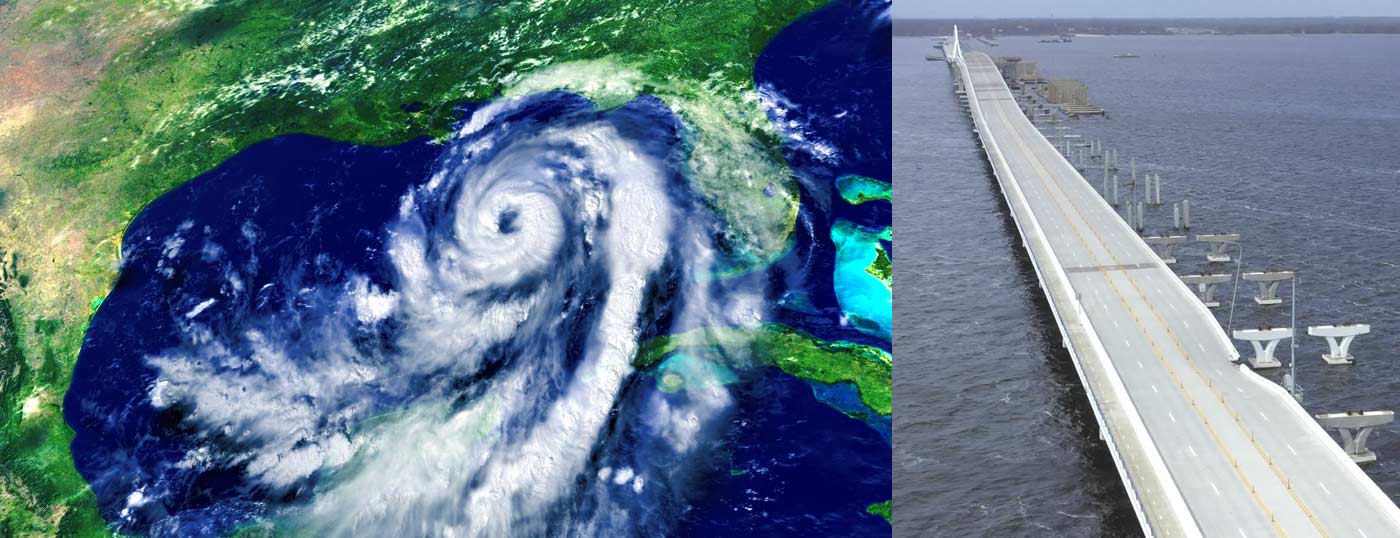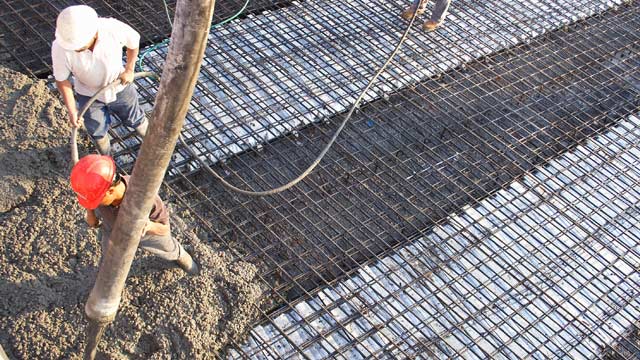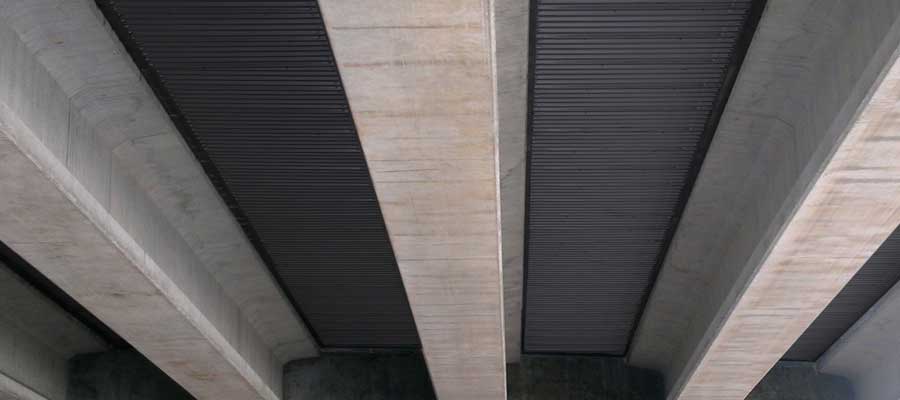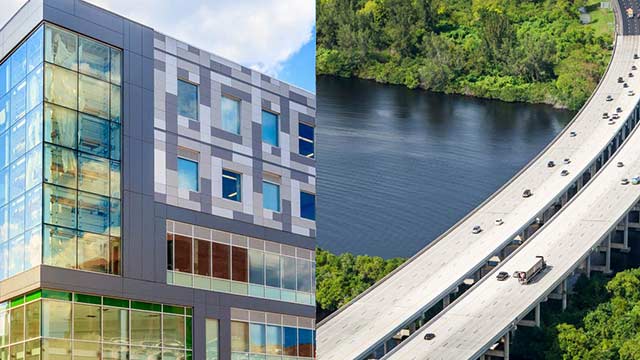
When Hurricane Sally struck the southeast coast in September 2020, the damaging storm made headlines but was soon out of the spotlight. Residents living and working in the affected areas, however, are still feeling the hurricane’s impact every day.
In and around Pensacola, Florida, the storm disrupted construction of the new Pensacola Bay Bridge that began in 2017. The $430.2 million project consists of two new parallel bridges (eastbound and westbound), each approximately 3 miles in length, replacing a single outdated, functionally obsolete structure. In September 2019 the eastbound bridge was complete and began carrying traffic in both directions. A Rhino-Dek® stay-in-place bridge deck form system from New Millennium is being used on the project.
Loading the player...
As Sally’s 105 mph winds moved in the morning of Sept. 16, 27 Skanska USA construction barges for the westbound bridge broke loose, with at least one of them striking and damaging the completed eastbound bridge. As a result, eight spans of the 104-span bridge must be completely replaced, and 14 other spans require partial replacement, says Gerald Arvay, a New Millennium district sales manager. For residents, that means no direct connection between the cities of Pensacola and Gulf Breeze, creating a range of travel complications and their related costs.
Arvay has been heavily involved in efforts to ensure repairs to the eastbound structure are completed as soon as possible so residents and businesses can regain a sense of normalcy.
“We’re focused on doing our part to help get these repairs done quickly and seamlessly so this area can heal and recover,” Arvay says. “This is a vitally important project for these communities, and we want to do our part to assist the people and the state of Florida.”
Besides the direct damage wrought by Sally, residents and businesses are suffering as the unexpected bridge closure impacts lives and livelihoods.
The Three Mile Bridge, as it’s known locally, connects the cities of Pensacola and Gulf Breeze, in Escambia and Santa Rosa counties, respectively. The bridge typically carries up to 60,000 vehicles a day between the two municipalities. Now, commuters must take a circuitous route using nearby Garcon Point Bridge to get from one city to the next.
Residents call the closure of Pensacola Bay Bridge “life-altering,” telling local newspapers of commutes that have grown from 15 minutes to 90 minutes and from under 10 miles to 70 miles—each way. Business owners in both communities say business is down, some at “devastating” levels.
Repairing and reopening the eastbound bridge will go a long way to easing the pain. New Millennium already has deck and accessories on site for westbound construction, which will help facilitate eastbound repairs, Arvay says.
“Our project management and customer service teams worked with the contractor to identify materials already on the job site for the new westbound structure that could be diverted to eastbound repairs so that work could begin immediately,” he says.
A return to normal sooner rather later will be music to people’s ears. Arvay expects the repair project, scheduled to be complete in phases beginning in March, will go smoothly.
There are several reasons bridge deck repairs will be swift, he says.
The eastbound and westbound structures are virtually identical, so using materials meant for the westbound bridge to repair the eastbound bridge will be relatively seamless.
New Millennium has been the supplier of the polymer-laminated stay-in-place bridge deck since the beginning of the project, giving workers a deep familiarity with the scope of work.
The bridge design is similar to that of the Choctawhatchee Bay Bridge, which also features New Millennium Rhino-Dek®. That project was completed in May 2016.


Crews began pouring concrete on the bridge deck the week of Jan. 11 and completed the concrete pour of the first of 8 replacement decks Jan. 13, the Florida Department of Transportation reported. Each complete span is 150 feet long, 59 feet wide and weighs approximately 2 million pounds.
While eastbound repairs progress, construction continues on the brand-new westbound structure. That presents a challenge for New Millennium, which must replace the materials diverted to the eastbound repair to avoid delays on the westbound construction while also producing the remaining materials for the repair as it meets the production requirements for the ongoing westbound construction. All of that must happen to meet both the March repair deadline as well as the overall project deadline of January 2022.
“Our production team has repeatedly demonstrated that they are up to the challenge with a virtually flawless record for on-time deliveries,” Arvay says.
In the course of repairs, Arvay says a challenge surfaced.
“While the requirements for the complete span replacements were relatively straightforward to our experienced engineering team, the partial span replacements involved additional challenges: evaluation of the component conditions where the structural repairs met the remaining original structure and determining the best means and method to connect the new Rhino-Dek® stay-in-place forming system to the remaining original girders,” he says.
“Our engineers quickly developed a solution using our post-installed Z-clip inserts, specifically designed for the widely used Florida I-Beam, which presents some unique requirements due to its wide, thin top flange.”
To endure corrosive saltwater environments, Rhino-Dek® features a polymer-laminate coating. Based on evaluations over three years of testing, that coating has a 124-year service life, the FDOT has concluded.
“Bridge deck is on the underside of the bridge between the girders; it is exposed to the elements,” Arvay says. “If it’s over salt water, it’s going to be exposed to salt air, salt fog, and if it’s low enough, it’ll be exposed directly to splash from the water.”

Ideal for spans over brackish and salt water, Rhino-Dek® is suitable for new construction and bridge rehabilitation projects such as the Pensacola Bay Bridge reconstruction.
“Even heavily galvanized steel can eventually rust, and salt will accelerate it. The Rhino-Dek® polymer comes between the salt and the steel on every exposed portion of the bridge deck system to extend the product life dramatically.”
“In an aggressive environment, it’s what you want to use.”

Bridge and multi-story projects at first glance seem to have little in common. A closer look, however, reveals these two types of structures often are constructed using building systems that are similar in many ways.

Steel joists and steel deck offer many benefits over other building systems, chief among them being reduced costs and improved project performance. But that’s just the tip of the iceberg.
Building a better steel experience